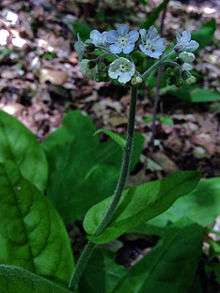Cynoglossum virginianum
| Cynoglossum virginianum | |
|---|---|
 | |
| Cynoglossum virginianum | |
| Scientific classification | |
| Kingdom: | Plantae |
| Clade: | Angiosperms |
| Clade: | Eudicots |
| Clade: | Asterids |
| Order: | Boraginales |
| Family: | Boraginaceae |
| Genus: | Cynoglossum |
| Species: | C. virginianum |
| Binomial name | |
| Cynoglossum virginianum L. | |
Cynoglossum virginianum, also known as the wild comfrey, is a plant native to North America. It is also sometimes called the blue houndstongue.
It gets its name from the appearance of its leaves that look like the a dog's tongue, which translates to Cynoglossum in Greek.
Distribution
Cynoglossum virginianum is native to the Eastern United States and across Canada. [1] It densely populates the central and southeastern parts of the U.S. and is often found in open uplands, such as in southern New England, from New York to Illinois, Louisiana, Oklahoma, and from the south to Florida. [1] Although Cynoglossum virginianum is ranked as globally secure by Nature Conservancy, the distinct northern variety, Cynoglossum virginianum var. boreale is disappearing from the southern part of it's range in the United States.[2]
Habitat and ecology
Studies indicate that some parts of the life cycle of C. virginianum are dependent on humidity, low temperature, and low competition. Therefore, a forest is a good place in which this species can be found.
Flowering and seedling require increased light and a richer soil. This is often achieved by random fires. This has not been researched but it can be said because other understory herbs require the same conditions. However, if there is too much light, then woody species may develop destroying the habitat and there is possibility for smaller herbs to take place.[2]
- Adaptations
Cynoglossum virginianum has adapted a unique ability to survive fire because, as mentioned above, it requires fire to eliminate competition and increase light to help nurture itself. This also as not been proven by research but history suggests that there may be a possibility that this species is adapted to occasional fires. This can be said due to the frequent fires the forest has gone through in which this species is found.[2]
Description
Cynoglossum virginianum is an erect, unbranched perennial with rough fine hair on its leaves and stem. Their leaves are simple, entire, and have an alternate pattern. The leaves are denser at the lower end of the stem and they get smaller going up the stem. It has two to six racemes. The flowers have five deep lobes that are connected to a superior ovary which in turn is connected to the style. The flowers have rounded, light blue corollas that overlap each other. The corollas alternate with stamen with anthers.
Unlike C. virginianum, C. virginianum var. boreale has petioles on its cauline leaves and its corolla lobes are not rounded and do not overlap. It, in general, is a smaller plant.[2][3]
Pyrrolizidine alkaloids, hepatoxins capable of affecting grazing animals and humans, are synthesized by many borages including Cynoglossum officinale. Presumably this provides some protection against generalist herbavores.[4] Botanists suspect that C. virginianum may also contain some of these alkaloids.[2][4]
- Leaves
- 10–20 cm long
- 2.5–7 cm wide
- Alternate
- Simple
- Entire
- Not margined
- Leaves get smaller going up the branch, towards the apical meristem[2][3][5]
Reproduction
Cynoglossum virginianum forms from a taproot every spring around May. Plants that do not flower grow more leaves in a rosette. However, the flowering plants grow from the center of the rosette. Cynoglossum virginianumis a monoecious plant which is self-compatible. It flowers from May to June and produces fruits from July to August. The flowers produce four grayish brown seeds that adhere to animals.[2][6]
- Flowers
- Flower size: 8–12 mm
- Flower color: Pale blue
- Pistil: superior ovary, deeply lobed into four parts.
- Corolla: 5-8mm wide, light blue, sympetalous, short tube, lobes oblong and do not overlap.
- Calyx: 1–3 mm
- Fruit
- 1-4 nutlets per flower
- 3.5-5mm each with one seed
- prickly
- convex surface
- protruding horizontally
- no margin[2][6]
Medicinal uses
Herbalists from the nineteenth-century have suggested that C. virginianum may possibly be a replacement or a substitute for Symphytum officinale (also known as Comfrey or Old West Comfrey.) For a long time, C. virginianum has been used to help treat wounds and to flush out any internal digestive disorders and respiratory infections. It also acts as a sedative medication.
Because of one of the active substances in the plant, large doses of it should not be taken because it can cause liver problems.[7]
References
- 1 2 "USDA: Cynoglossum virginianum distribution map".
- 1 2 3 4 5 6 7 8 "Conservation Assessment for Northern Wild Comfrey (Cynoglossum virginianum var. boreale (Fern.)Cooperrider)" (PDF). USDA Forest Service, Eastern Region. July 2005.
- 1 2 A.Gleason, Henry (1963). Manual of Vascular Plants of Northeastern United States and Adjacent Canada. New York: D. Van Nostrand Company, INC. p. 576.
- 1 2 Shen, X; Bourg, NA; McShea, WJ; Turner, BL (March 28, 2016). "Long-Term Effects of White-Tailed Deer Exclusion on the Invasion of Exotic Plants: A Case Study in a Mid-Atlantic Temperate Forest" (PDF). PLoS ONE. 11 (c). doi:10.1371/journal.pone.0151825. Retrieved 2017-04-01.
- ↑ Britton, Nathaniel (1970). An Illustrated Flora of the Northern United States and Canada. New York: Dover Publications, INC. p. 76.
- 1 2 D.Cox, Donald (1985). Common Flowering Plants of the Northeast. Albany: State University of New York. p. 46. ISBN 0-87395-889-6.
- ↑ "2bnthewild.com: Wild Comfrey (Cynoglossum virginianum)". Retrieved 6 July 2012.